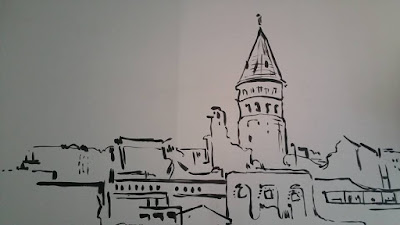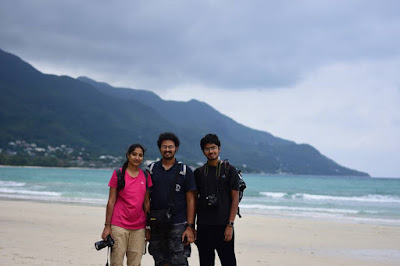 |
| A neat little sketch |
Ever since I played Assassin's Creed Revelations, I had wanted to visit Istanbul. The game takes place in the old part of the ancient city, mainly focussing on Galata and the Sultanahmet-Beyazid areas. Crowned the Culture Capital of Europe in 2010, the city has a lot to offer to the discerning eye. Roadside stone blocks bearing the inscriptions 'Imperator Theodora' (the wife of the emperor Justinian I). A treasure of ancient Persian and Greek relics in the Archaeology museum. The Hagia Irina and Hagia Sophia. The staff of Moses and the saucepan of Abraham. And the sheer awesomeness of the Basilica Cistern. The city is bound to saturate even the most die hard history buff. This blog is about my visit to Istanbul in July 2015.
 |
| The random rock on the road with the inscription of Empress Theodora. |
This was not meant to be a Turkey trip. We had no plans to visit any other place around (except Troy if it were possible). I wanted it to be a week's worth of Istanbul. Every single art museum, mosaic museum, mosque, church and palace! Amogh joined for this trip and we booked a Qatar airways flight to Sabiha-Gokcen (SAW), via Doha on 27th July.
We landed in SAW on 27th afternoon and swapped the US dollars for about 1300 TL each. We headed off to our hostel via the Havatas airport shuttle. It dropped us at Taksim square and we were fleeced by a local taxi driver who finally dropped us at our hostel. It was called Bourse Galata and was about a few minutes walk from the Galata tower and also from the Karakoy station. The hostel was filled with people from all possible walks of life. A Kurdish fighter from Syria, an immigrant from Peru, a spice merchant from Morocco, a biker from Greece and a couple of Spaniards. We set off on our first outing the moment we reached the hotel.
 |
| Fatih district of Istanbul, from Galata Tower |
 |
| The Hagia Sophia |
 |
| Topkapi Palace |
We walked up to the Galata tower, asking the locals for directions. It was dusk and the sun was setting. The view from atop the tower was breathtaking. Sulemaniye mosque was on the horizon. The iconic Blue Mosque (Sultanahmet mosque) and Hagia Sophia stood out clearly near the place where the Golden Horn starts. Other mosques such as the Yeni Camii were visible as well. The centre of Ottoman power, the Topkapi palace stood out with its massive tower near the entrance to the Golden Horn. The city started lighting up as the sun went down and we spent a good one hour atop the tower. This tower was built in the early Byzantine era (around 530 AD) to serve as a lighthouse.
 |
| Byzantine icon of Virgin Mary and Jesus. |
 |
| Pages from the very first copies of the Quran |
 |
| Quran's verses |
|
 |
| The great dome |
The next day we visited the single greatest monument the city had, the Hagia Sophia. The Hagia Sophia needs no introduction. The iconic mosque was once the greatest church in the Christian world, pre-dating the St. Peter's Basilica by a thousand years. The oldest part of it was opened during the reign of Constantine II in AD 360 in the Eastern Roman Empire. It was obviously very crowded. But it was beautiful. The Ottoman calligraphy dominates the great dome, which has 200 verses of the Quran painted onto it and is surrounded by Byzantine angelical icons. The high altar had a massive mosaic of the Virgin Mary with an Ottoman praying area below it facing the Kaaba. The calligraphies of the Prophet and the sultans stand side by side with Byzantine mosaic of the angels and crosses. Once the greatest church in the Christian world, it became the greatest mosque in the Muslim world after the Turks conquered the city. The four minarets came as a result of this conversion. The area in between the Hagia Sophia and the Sultanahmet mosque is a very happening place, vibrant and full of activity. We visited the Museum of Islamic Art, which is just behind the Sultanahmet mosque. It contains the personal articles of the Prophet, including his beard and the very first copies of the Quran. The rest of the day was spent in taking the legendary cruise in the Bosphorous. It was on a modified ferry and it sailed out of the Golden Horn and into the Bosphorous, crossing the bridge (towards the Black Sea) before turning around and sailing back. We spent the evening at the Dervish cafe, watching the famed dervishes whirl to devotional Sufi music.
 |
| Istanbul skyline |
 |
| Beyazit Kapali Karsi (Grand Bazaar) |
 |
| Remains from the bombardment of 1453. |
 |
| The head of Medusa |
 |
| Bust of Alexander the Great |
We started the second day by taking a local train from Karakoy to Topkapi. The triple wall system which defended the city for millennia passes through Topkapi. What's so special about that place is that this is where Mohammed II (the conqueror) entered Constantinople in AD 1453. These walls protected the city for centuries from conventional siege weapons but were no match for gunpowder artillery, which ultimately brought them down. Parts of the wall stand to this day and we chipped a rock from the wall and brought it back to India as a souvenir. We took a train back to Beyazit to visit the Grand Bazaar. The largest covered market in the world, it was opened only two years after the fall of Constantinople, in AD 1455. A little unassuming entrance, just 50 meters from Hagia Sophia led to the Basilica Cistern. The biggest of over 300 cisterns which lie beneath the city, this place truly deserved its name 'the sunken palace'. What was interesting is that there is an element of Greek mythology involved in its construction. There are three Medusa heads which are engraved into three stone columns. We then headed to the Archeology museum. Three-fourths of the museum was closed. So we got to see only one part of it. Opened in the mid 19th century, it housed exhibits from all corners of the Ottoman Empire. The fact that the empire covered Egypt, Mesopotamia and parts of Persia ensured that there will be a rich collection. Egyptian mummies and their sarcophagi, reliefs from Sumeria, Assyria and Palmyra. Relics and wall engravings from the ancient city of Babylon. A bust of Alexander the Great, probably carved while he was alive! We decided to revisit this place!
 |
| Basilica Cistern |
 |
| Topkapi Palace |
 |
| The Imperial harem |
 |
| Arasta bazaar |
 |
| Sultanahmet mosque |
The third day took us to the centre of Ottoman power, the Topkapi Palace. Built over the old Byzantine Great Palace of Constantinople, it overlooks the starting of the Golden Horn. It has remains of its Byzantine past in some parts. It has four main courtyards and a harem. The single greatest thing about the palace is the relic collection. Its privy chambers contain some of the holiest relics of the Abrahamic faiths, including the personal belongings of Abraham, Moses, David and the Prophet. Articles belonging to the Prophet's family and first caliphs are on display as well. The restaurant in the palace served some awesome sherbet and offered a great view of the Golden Horn. Unlike the Holy Roman empire, the Ottoman sultan was also the caliph, concentrating all the political and religious power in this single place. I think this kept the empire more stable as there was no Emperor-Pope-Anti Pope triangles involved. The harem was the most beautiful part of the palace, being rich in calligraphy and art. We then headed to Arasta bazaar where I bought a mother-of-pearl ring and a silk scarf (from Bursa) for Srivani. The next destination was the mosaic museum, which was mostly from the Greek and Roman era. It depicted everyday life in the area. Bear hunting, safaris, city life and so on. We spent the rest of the evening near Sultanahmet mosque.
 |
| Greek mosaics |
 |
| Galata Mevlevihensei |
The fourth day started in the Galata Mevlevihensei. This was a Sufi monastery, not far from where we lived. Models depicting everyday dervish life were on display, as were their articles. The first floor of the building had the main stage where the dervishes used to whirl, seeking divine grace. After a quick lunch, we set out to explore the rest of the Archaeology museum. An entire floor of the ancient collection was divided into 9 parts. One for each Troy. It was an overdose of history as we poured over love poems and home remedies from around the time of Homer (nearly 3000 years ago). We even visited the Byzantine and the Ottoman parts of the museum. The Ottoman area was mostly filled with calligraphy and ceramic art.
 |
| Entrance to the Islamic section of the Archaeology museum |
 |
| Istanbul Archaeology Museum |
 |
| The millennium stone (the centre of the city) |
 |
| Valens aqueduct |
 |
| Valens aqueduct |
 |
| Cemberlitas |
The city was formed out of a necessity of a second capital at the height of the Roman Empire. It bore the name of its founder, Constantine for a thousand years. So I set out to look for major remains from the time of the Roman empire. The first stop was Cemberlitas. The forum of Constantine, this was once a site of a great market. 1700 years later, all that remains is a single column with some Latin inscriptions. I went to have a chat with a bookshop guy nearby and he directed me to another Roman artifact. The Valens aqueduct. Romans built aqueducts to supply water to their cities and they were considered a marvel of engineering of the time. This particular aqueduct straddles a major artery of the city and looks pretty imposing.
 |
| The latin inscriptions on the Forum of Constantine (Cemberlitas) |
 |
| Icons at Chora church |
 |
| Icons at Chora church |
The fifth day took us to a far away church, the Chora church. This place had a great collection of Byzantine icons. In fact the entire church was filled with icons. They were probably saved during the iconoclasm. We returned to Sultanahmet and visited the Hagia Irina. This place was as old as Hagia Sophia and is still Christian. Unfortunately it was under renovation and we couldn't explore much. We paid a visit to the tombs of the sultans in the Hagia Sophia compound. We also visited the second largest cistern under the city, the Cistern of Theodosius, named after the emperor who built it. We spent the evening at the southern most beach of the city, facing the Aegean and Mediterranean seas. This is the sea of Marmara. The place was crowded with ships.
 |
| Byzantine iconography |
 |
| The sea of Marmara |
The last day of the journey was spent in taking ferries around the city and an experience of the spice bazaar (Egyptian Bazaar). We returned early this day and prepared for the departure to India the next morning.
This trip satisfied the history buff in me and I look forward to the next one!



































Well written sir...summarized view of Istanbul.
ReplyDeletePut almost entire Istanbul in one page.